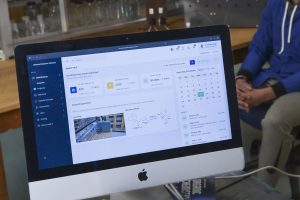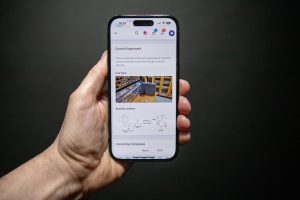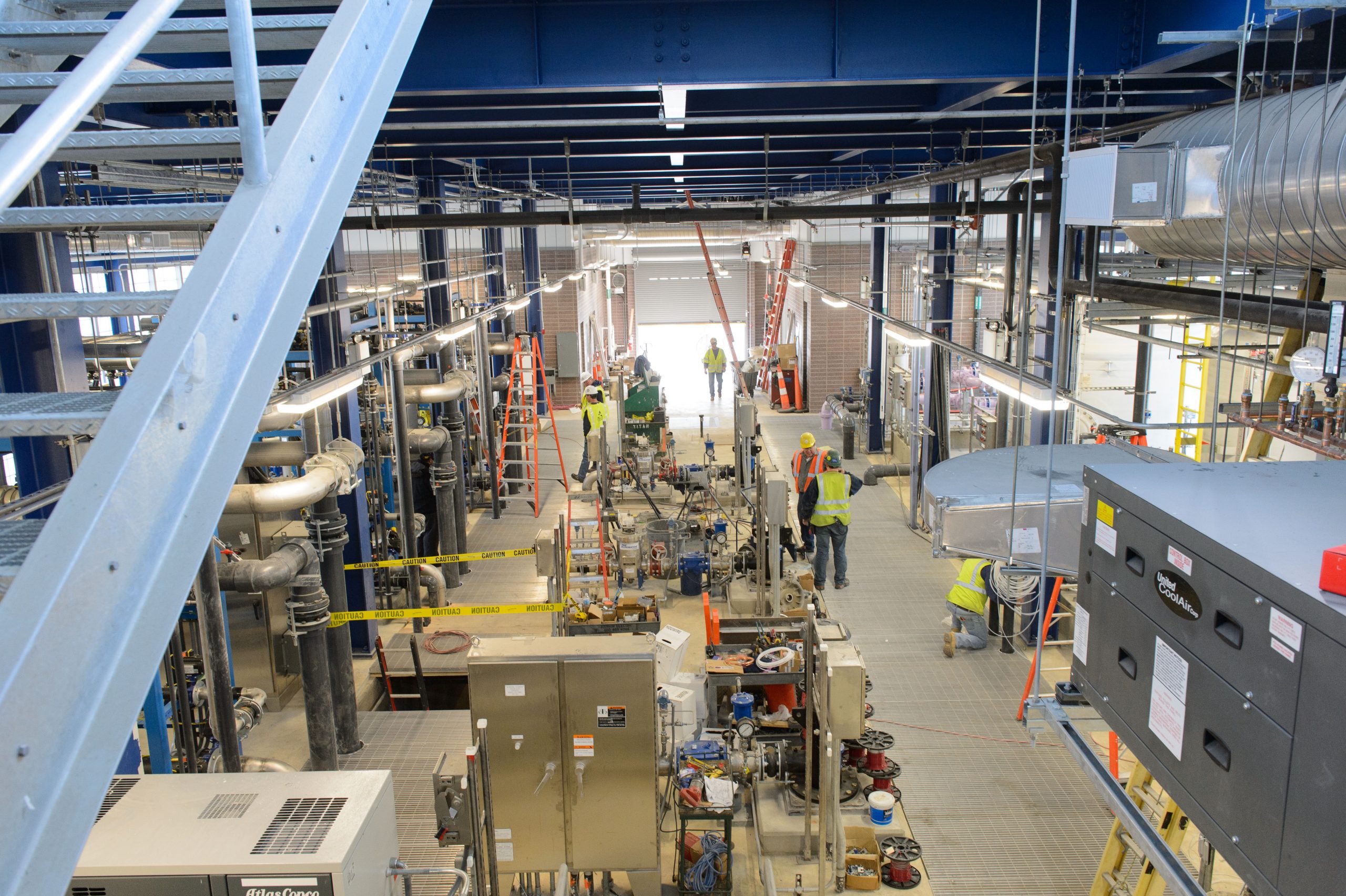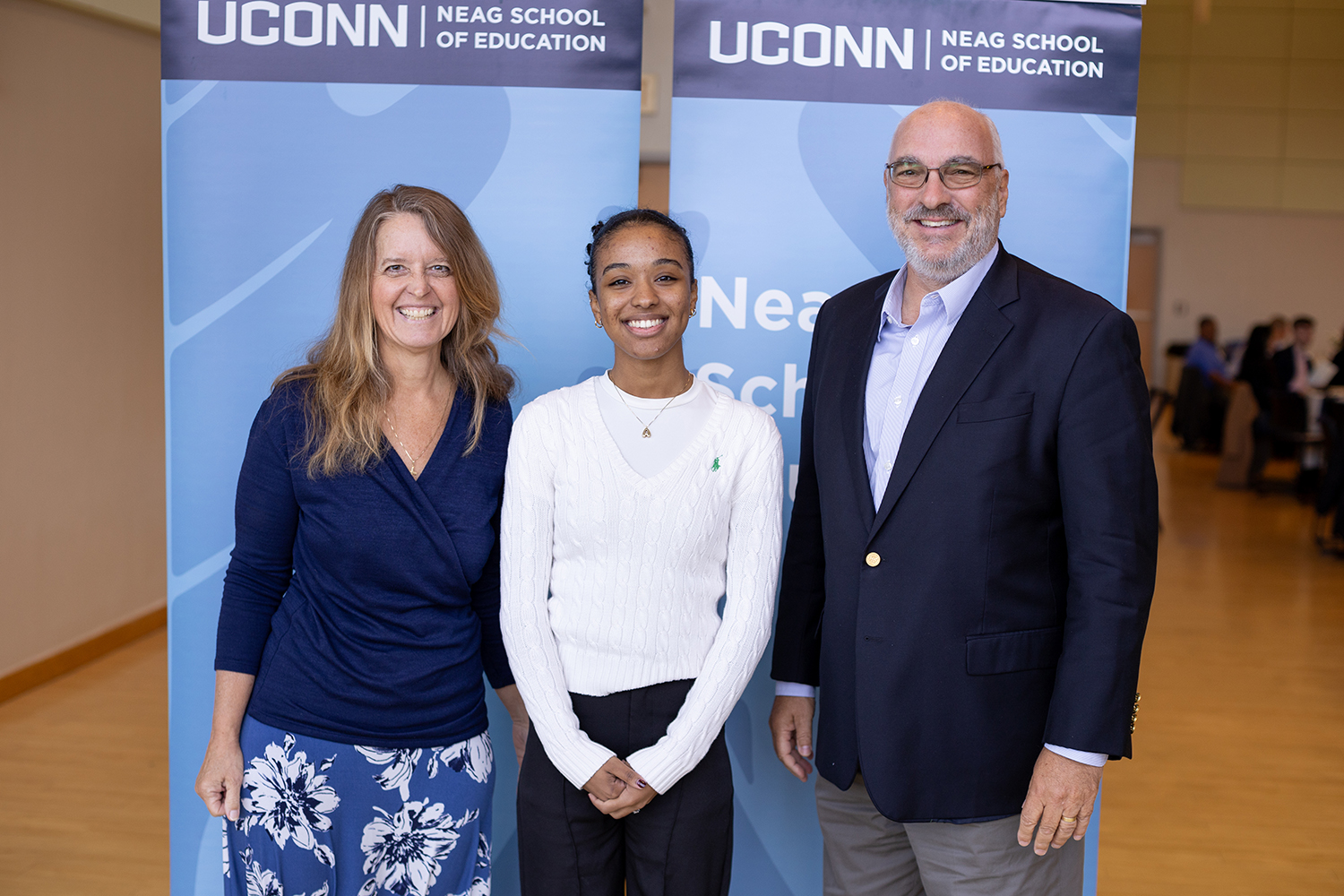In the exact same way that any average person opens their phone and taps on any ordinary app to check their email, or check the weather, or check social media, Kerry Gilmore swipes his thumb across his phone’s glass screen and taps an app.
This app isn’t ordinary, though – it’s a direct link to some of the sophisticated, automated instruments in his chemistry lab at UConn Storrs as well as to information about and data produced through the lab’s many research projects.
But if they have the interest, any average person could tap that app, too.
They can examine the data from experiments already run, automate processes to run experiments of their own, and contribute to those ongoing projects, all through the app.
That easy access to active and developing science at UConn is completely by design.
“What we are trying to do is to open up access to being able to do research,” says Gilmore, an assistant professor in the Department of Chemistry at UConn’s College of Liberal Arts and Sciences.
“One of the biggest limitations to being able to participate is not having access to the kinds of tools and technology that are necessary in order to do that science.”
A lot of chemistry training, he explains, involves learning and practicing how to conduct chemistry experiments, which can be limited both by location and the availability of equipment, as well as an individual’s aptitude for learning those physical and technical skills.
“But in theory, training should be about teaching you how to think, be creative and problem solve, and to come up with wonderful new solutions for things,” Gilmore says.
And it’s that limiting dynamic that Gilmore and his team hope to change – one chemistry lab and one automated tool at a time – through this app, and through a unique and growing outreach program aimed at engaging Connecticut high school students who are interested in science.
Changing the Game
Gilmore is an organic chemist and a flow chemist. He came to UConn in 2020 after completing his post-doctoral fellowship and then working as a research group leader for six years at the Max Planck Institute of Colloids and Interfaces in Germany.
Flow chemistry differs from traditional, or batch, chemistry in that the process involves reactants continuously traveling through tubing using pumping systems. The advantage of flow chemistry, explains Gilmore, is control.
“We now have a stable set of conditions that we pass our solutions through,” he says, compared to batch processes. “Traditionally, we do chemistry a lot like cooking. You basically throw a bunch of stuff in a pot, heat it up, and hope it works. Flow chemistry is more like an assembly line, getting the same product every time.”
Conducting experiments using flow chemistry systems has typically meant that chemists needed not only access to the equipment but also the knowledge and skill to operate it. Chemistry has the potential to be dangerous – some reactants are caustic or flammable. Gases can be toxic. Things can blow up, both literally and figuratively.
But in chemistry, as with so many fields, technological advancements are changing the game.
“There’s lots of technology has been developed over the last 10, 15 years or so looking at automation, cloud computing, and everything that we can do online,” Gilmore says, “where we basically outsource everything from a technology standpoint, and we then have this interface that allows more of us to actually do things. We’ve taken the same approach, using automation and advanced instrumentation to remove the skills and expertise required, allowing more of us to do chemistry. We can simply tell it what we want to do, hit go, and the system does the rest.
“And what we realized is that if we can control that from a computer, that means we can control it from anywhere.”

When Gilmore says “anywhere,” that’s exactly what he means – anywhere could be his office on the other side of the Chemistry building, or in the dorms across campus, in another part of the state, or in another part of the world.
“You can be someone in Stamford doing this, but you can then also be someone in Bogota, Colombia, running these things,” he says. “And it’s the same experience, and it’s the same data.”
The system that Gilmore and his team built is called the Remote Research Network, or RRN. The app is free to download, and it’s currently free to sign up, though they may begin charging nominal fees to cover the small cost of reactants used in the automated machines down the line as the network grows.
Participants who join the network can view all of its active research projects. They can schedule and run experiments of their own. They can converse with other researchers and add their own creative thoughts and ideas to a project.
All of the data generated through the experiments is considered open source and is stored on the network – everyone can see what worked and, just as important to Gilmore, what didn’t.
“Everything that you run is open and live, and that, I think, is where we’re going to see the most transformational change in how we do science,” he says. “If you’re looking at trying to bring in all of the beautiful data sciences that are being developed, and how we can continue to accelerate and figure out how we can solve more and more complicated problems, it doesn’t work if it’s just, ‘Everything is great!’ We need to know the full story – and that’s something that’s lacking in the way we share scientific data currently.”
Also important is that absolutely anyone can participate. No Ph.D. necessary. No background in chemistry involved. A college degree or high school diploma isn’t required, either.
Curiosity and interest are the only requisites.
Building Self Efficacy
For UConn students, access to instruments through the RRN means that they can work on research projects remotely at any hour of the day – not just when someone who knows how to operate the equipment is around.
For other faculty at UConn, the RRN has the opportunity to break down barriers that might otherwise hinder research.
“Oftentimes, the reason that we collaborate is because, if I’m an organic chemist studying how to deliver RNA or something like this, and I don’t know how to make something, I have to go knocking on people’s doors saying, ‘Hey, will someone make this for me?’” Gilmore explains. “Then, I have to convince that person that this is interesting enough, and hope they stay motivated enough in order to make the things I need to do my science. That’s often where things just fall apart.
“Whereas, what you could be able to do is say, ‘I want to make this thing.’ OK. I know I can use this automated platform, and it will remove all of the physical skills that are necessary in order to do this. That allows more people to participate and do the science they want to with fewer bottlenecks.”
It also allows complete outsiders to enter the process – including high school students.
“The overall idea for this is that if we can get more people involved, if more people can actually participate in research, then the higher the chances are that people can find that they are interested in this,” says Gilmore. “They can build self-efficacy belief that ‘I am a scientist. I can do this.’”
A few years ago, Gilmore brought the RRN to UConn’s Early College Experience program, or ECE. The ECE is a concurrent enrollment program that allows motivated high school students to take UConn courses at their high schools for both high school and college credit.
Gilmore presented one particular piece of his research program to the ECE – a project involving an anti-malarial medication derived from a natural product called artemisinin that is synthesized from a plant called Artemisia annua, or sweet wormwood – and working with ECE members from local high schools, created a multi-stage outreach program where high school students could participate in research.
Through the program, teams of students first grow their own plants, and then learn a process to extract compounds from the plants. They’re provided with basic equipment to make their extracts, and smaller, automated equipment to test these compounds themselves. The data they generate is shared with their peers, and the compounds they find are working get delivered to Gilmore’s lab.

Once their samples are loaded into the larger platforms at UConn, the students can then control the automated processes through the RRN app to run their own experiments and receive and analyze their own data.
The outreach program was first piloted at Berlin High School, in Berlin, Connecticut; then extended to Platt High School in Meriden; and is now also at Norwich Free Academy in Norwich.
And what started with sweet wormwood has expanded to any plants that the students want to try to cultivate and investigate – giving them an opportunity to expand their own unique and creative interests.
“What’s been really fascinating is you start to see them get excited and interested in this for multiple reasons,” says Gilmore. “There are the kids that are really into the botany side of things. Awesome. They find that they get to take ownership over this portion of things. Then there are people that are interested in more of the engineering side of things, building the setups. Some are running the chemistry. And so, people can find their niches, discover their passions. If we have enough different areas that we can cover, we can get more people excited about this.”
Building Community
It was through Platt High School’s program that Edrik Morales ’27 (CLAS) first met Gilmore and learned about his lab.
“I love science, specifically, the physical sciences – biology and chemistry, anything in that,” says Morales, who graduated from Platt as valedictorian of his class in 2023 and started his first year at UConn Storrs this past fall, where he’s double majoring in molecular and cell biology and chemistry.
In his senior year of high school, Morales joined the RRN outreach program, visited Berlin High School, learned how to use the pumping systems, and contributed to the anti-malaria research program. But he joined the program late in his high school career, and when he came to UConn, he felt like his work with it wasn’t done, yet.
“I’m not the type of person to leave things unfinished,” Morales says. “I like to involve myself in any way I can. I’m a really big fan of getting things done.
He reached out to Gilmore, who invited him to join the lab. For the last few months, he’s been working again on the RRN outreach program, but this time from the other side – helping to build and calibrate the pump systems that are distributed to the partner high schools.
Making these pumps – this is just kind of the tip of the iceberg, I feel, for what the future of education can look like in the sciences.” — Edrik Morales ’27 (CLAS)
“Making these pumps – this is just kind of the tip of the iceberg, I feel, for what the future of education can look like in the sciences,” he says. “It’s giving students a grasp of what things may look like, if they want to work in a lab or do any form of research, and it helps establish that independence in them.”
Morales hopes to eventually go to medical school – his dream is to become a heart surgeon.
And the systems he’s helping to build now will assist in bringing an additional four high schools into the RRN outreach program in the near future, and hopefully more beyond that as the community around the program continues to grow.
“What we really want to do once we have a good handle on how to do this is to bring this to all of these other schools that don’t have the same resources, that are in economically disadvantaged areas, that have much higher minority populations,” Gilmore says, “to try to use this as a way to encourage students who may not see themselves as scientists, who may not be thinking that they can go on and do these sorts of things, to give them that experience and that confidence so that they can try to pursue this, if that’s something they’re interested in.”
While the RRN is currently localized only to Gilmore’s lab, his team’s hope is to eventually add other labs, with other automated instruments, working on other types of research, in other places around the country and the world, into a vast network that can not only be inclusive, but also can help to accelerate the progression of science.
And Gilmore himself hopes that, in the future, he won’t have just two or three co-authors on a paper, but 50 or more – and that some of them will be the high school students who have participated in the outreach program and contributed data to his own projects.
“There’s so many ways that we can participate, and what we’re trying to do with is facilitate community,” says Gilmore. “You don’t have to have a specific program. If you’re the only one at your school who thinks that they can become a chemist, or an engineer, or a biologist, or anything else, great! Come on over. We can help you. You’re not alone. There is support for you. There are ways that you can advance in these things.
“Because your choices shouldn’t be restricted to what you have access to if we can all access the same things.”
For more information about outreach opportunities at UConn, visit outreach.engagement.uconn.edu.

